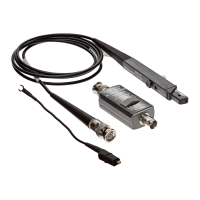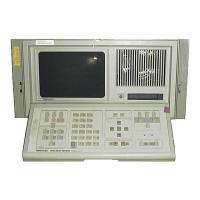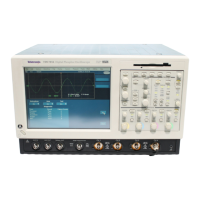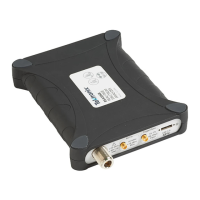Section 9 - Diagnostics
VM700A Option 01 (NTSC) & Option 11 (PAL) User Manual
9-5
Table 9-2: Individual Diagnostics (Cont.)
Board Tested DescriptionTest Name
ÁÁÁÁÁÁ
ÁÁÁÁÁÁ
ÁÁÁÁÁÁ
ÁÁÁÁÁÁ
ÁÁÁÁÁÁ
Analog Input (cont.)
ÁÁÁÁÁÁ
ÁÁÁÁÁÁ
ÁÁÁÁÁÁ
ÁÁÁÁÁÁ
ÁÁÁÁÁÁ
Clamp (for each channel)
ÁÁÁÁÁÁÁÁÁÁÁÁÁ
ÁÁÁÁÁÁÁÁÁÁÁÁÁ
ÁÁÁÁÁÁÁÁÁÁÁÁÁ
ÁÁÁÁÁÁÁÁÁÁÁÁÁ
ÁÁÁÁÁÁÁÁÁÁÁÁÁ
Checks each channel’s clamp level DAC for range and
bit weights. Verifies each DAC for independence by
changing the other two and monitoring the one being
tested to verify that its range and bit weight remain
unchanged. Measures fast- and slow-clamp response
time by timing a 100 mV clamp-level change. Verifies
fast clamping at each possible clamp-pulse width.
ÁÁÁÁÁÁ
Filter
ÁÁÁÁÁÁ
Times 8 Gain
ÁÁÁÁÁÁÁÁÁÁÁÁÁ
Using the ADC, two Cal DAC DC levels are measured
with x8 gain off, two more with it on, and the gain is
calculated from the ratio of the differences.
ÁÁÁÁÁÁ
ÁÁÁÁÁÁ
ÁÁÁÁÁÁ
ÁÁÁÁÁÁ
ÁÁÁÁÁÁ
ÁÁÁÁÁÁ
ÁÁÁÁÁÁ
ÁÁÁÁÁÁ
ÁÁÁÁÁÁ
ÁÁÁÁÁÁ
ÁÁÁÁÁÁ
Successful completion of
these tests requires that
Genlock (A2), Controller
(A8), Acquisition (A7), and
Analog Input (A1) boards
be operating correctly.
ÁÁÁÁÁÁ
ÁÁÁÁÁÁ
ÁÁÁÁÁÁ
ÁÁÁÁÁÁ
ÁÁÁÁÁÁ
ÁÁÁÁÁÁ
ÁÁÁÁÁÁ
ÁÁÁÁÁÁ
ÁÁÁÁÁÁ
ÁÁÁÁÁÁ
ÁÁÁÁÁÁ
Filter Slot n (for slots 0
through 5)
ÁÁÁÁÁÁÁÁÁÁÁÁÁ
ÁÁÁÁÁÁÁÁÁÁÁÁÁ
ÁÁÁÁÁÁÁÁÁÁÁÁÁ
ÁÁÁÁÁÁÁÁÁÁÁÁÁ
ÁÁÁÁÁÁÁÁÁÁÁÁÁ
ÁÁÁÁÁÁÁÁÁÁÁÁÁ
ÁÁÁÁÁÁÁÁÁÁÁÁÁ
ÁÁÁÁÁÁÁÁÁÁÁÁÁ
ÁÁÁÁÁÁÁÁÁÁÁÁÁ
ÁÁÁÁÁÁÁÁÁÁÁÁÁ
ÁÁÁÁÁÁÁÁÁÁÁÁÁ
Slot 0 is a bypass path, rather than a filter slot. These
tests include filter ID and frequency response sub-tests.
The filter ID sub-test checks instrument firmware to
determine the TV standard and release version. This
information is used by the diagnostic to determine valid
filter IDs for each slot.
The frequency response sub-test generates a psuedo
square-wave signal by switching channel input between
A and B, with each channel input clamped to a different
DC level. The signal is routed through the filter slot
under test to the ADC, acquired, and analyzed.
Discrepancies are displayed on screen. When an empty
slot is correctly identified, this test displays NA.
a
Each gating pattern has a different number of active video lines, so the ratio of the NTSC-pattern cal
factor to always-on pattern equals the ratio of NTSC pattern active lines to the always-on pattern
number. Likewise for PAL.
b
Range is the arithmetic sum of the measured bit weights, and bit weights are measured as the effect
of toggling only the indicated bit.

